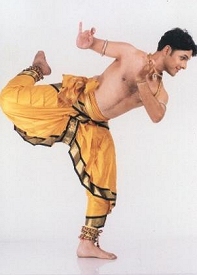Narthaki

News

Info

Featured


|
 |
Nayika Bheda- s - aka pamper the male ego - Parimal Phadke e-mail: parimalphadke@hotmail.com August 27, 2005 From Bharata's Natyasastra to the later texts on dramaturgy and poetics, Nayika has always been a topic of interest. It is not surprising that the later texts identified many more. In spite of so many classifications, it is a fact that Nayika is a purely male point of view. May it be the Natyasastra-s or the Kavyasastra-s, we see the classification to suit the male sex. It goes without saying that all these sastra-s were written by males. Thus the Nayika Bheda-s more or less try to emphasize that a female is always the weaker sex. The Nayika Bheda-s are the proof highlighting their low status in the society. The following illustrations will make the point clear - 1) Promiscuity seems to be a Nayaka's birth right that does not apply to the Nayika. There is a separate category for a nayika who has an extra marital affair, who has been termed as the "Parakiya" (literally meaning somebody else's). Here she is only granted the permission to indulge in one man besides her husband. If she is promiscuous, she has been termed as "Kulta." The same criteria has not been applied while judging the Nayaka. In fact his extra marital relations have been glorified in "Shatha," "Dhrshtha" or "Dakshina" . Though the titles "Satha" and "Dhrshtha" do have negative connotations, they don't appear as blasphemous as the title of "Kulta" given to a Nayika. The bias seems to be very evident. 2) Interesting is the politics to define a "Jyestha" and a "Kanistha." A "Dakshina" nayaka is the one who is courteous to both his wives/women. Interestingly, the "Jyestha" or the elder wife has been defined as the one who is the favourite of the Nayaka and the "Kanistha" is the one who plays second fiddle. Thus "age" does not seem to be the criteria but it is the bias of the Nayaka, which decides the Nayika as "Jyestha" and "Kanista." 3) Even a Nayika in her teens becomes an object of beauty and lust. Vivid examples of her in the "Agnyat Youvana" (one who is not aware of her youth) have been written. The same does not apply to the Nayaka. In fact, the Rasamanjari says that an Anabhijnya (who is unaware of his youth and feelings of love - teenage) Nayaka will lead to Rasabhaasa. 4) Incredible is the criteria to judge a nayika as "Uttama," "Madhyama" and "Adhama." If a Nayika criticizes a Nayaka openly for being unfaithful to him, she either becomes a person of "Madhyama" / middling, or "Adhama" /inferior Prakriti (nature). It is only when she criticizes in a subtle manner and accepts the Nayaka-s infidelities, she becomes the "Uttama" or superior Nayika. 5) Similar is the classification of "Kalahantarita." Generally she has been defined as the one who is separated due to a conflict with her Nayaka. Most of the examples dealing with this Nayika show her repenting about the manner in which she misbehaved with the Nayaka for his misdoings.  Even more shocking is the fact that in some of the Kavya sastra-s the author has made a separate category of "Prohibitive women" or "Varjya," where the author cautions that men should not indulge in such women. Alas! Such a caution was not given to women. Being a Bharatanatyam dancer there are innumerable questions ringing in my mind. For how many years more are the female classical dancers going to take pride in performing compositions of this content? Or as usual, I am going to witness the very typical clichéd answer that the Nayika is the ‘Atma' and the Nayaka is the "Paramatma," which can cleverly avoid the larger question of "Gender Bias." I am waiting for a day when the 21st century female classical dancer rewrites her version of Nayika Bheda-s.Anybody listening.....? References Illustrations taken from Rudrata pranita "Kavyalankara" translated by Dr. Satyadev Choudhary (Hindi). Parimal Phadke is a Bharatanatyam dancer, choreographer and teacher from Pune. His remarkable contribution is the interpretation of the concept of Nayaka in the Bharatanatyam Margam. More info on him at parimal.xp.com |